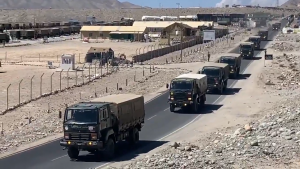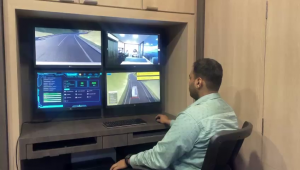Understanding the significance of military vehicle simulators for preparing Indian military forces
Countries all over the world are facing security threats due to border disputes with neighboring nations, terrorist attacks, and communal disharmony. Modern-day security challenges require modern equipment and systems to combat enemies. Modernization of defense forces has thus become the need of the hour. Modernization of defense forces involves the acquisition of platforms, technologies, and weapon systems to enhance defense capabilities. The government of India has recently approved military modernization projects worth $9.8 billion. The government is now actively taking initiatives and introducing policies to modernize Armed Forces, Navy, and Air Force into defence simulators for training. With new equipment and technologies being inducted into the defense forces, it is important to impart quality training to defense personnel to ensure the optimum utilization of military vehicles and weapons. This article will explore the need for the modernization of defense forces and the latest technologies like military vehicle simulators to train defense personnel.
Modernization and indigenization of fleet
India is an aspiring superpower that aims to strengthen its defense forces and gain an edge over its rivals. India has been facing internal and external security threats in the form of terrorist attacks, insurgency, and border disputes for a long time. With security threats increasing day by day and technology making inroads in the defense sector, India is focusing on the modernization and indigenization of its fleet. Indigenization reduces the burden on imports and increases the country’s capability to produce equipment in the country.
Though India is currently acquiring some of the defense equipment from international markets, the aim is to minimize reliance on other countries and become self-sufficient. The government of India’s ‘Make in India’ program encourages the indigenous design, development, and manufacture of defense equipment in the country. The Government has approved a scheme with an outlay of Rs 498.78 crore (2021-22 to 2025-26) that promotes innovation in the Defense and Aerospace sector. The scheme also supports participation from more than 300 start-ups in new design and development projects. The modernization plan includes acquiring lighter personal kits, ballistic helmets with communication facilities, lighter weapons, and body armor (bulletproof jackets, trainer jets, unmanned combat aerial vehicles. India now has future-ready combat vehicles like night-enabled tanks and ICVs.
The growing popularity of VR in military training
Simulated computer-based training has been used in the military since the 1980s because it allows soldiers and military personnel to train in a safe and controlled environment. Virtual Reality training is expanding these opportunities by taking computer-based training to the next level.
Its popularity stems primarily from its ability to provide a completely realistic, immersive experience that perfectly mimics everyday scenarios from the lives of ground troops, the air force, the navy, and special units. Virtual environments are ideal for military training. VR technology allows participants, such as soldiers, to experience specific situations in a controlled environment and under monitored conditions. It allows trainees to hone their skills and put their abilities to the test in fast-paced situations that will prepare them for combat and national defense.
Significance of military vehicle training
A violent, fearful, and aggressive environment is conducive to combat. The consequences for untrained defense personnel are devastating. In order to accomplish the mission as a team member, defense personnel must be prepared to fight enemies. In addition to its geography, the armed forces are also faced with difficulties operating on difficult terrains such as glaciers, high mountains, and sandy deserts. Operating military vehicles in such terrains requires excellent skills. Both individual training and group training sessions are necessary to prepare military forces.
Individual training programs are designed to develop individual skills whereas group training sessions are designed to integrate trained individuals into a cohesive and effective team. Military vehicles include tanks, trucks, tractors, trailers, vans, and artillery pieces, among others. Armed forces are expected to operate these vehicles in challenging conditions without compromising efficiency. Military training is therefore essential for individuals to perform physically and mentally demanding tasks at the highest possible levels of proficiency.
Role of simulators and VR solutions
Military training must continuously evolve and keep up with the latest developments. Training programs should be forward-thinking and innovative. Modern military equipment systems require persistent training with sophisticated technologies to achieve efficiency in operation. Simulators have emerged as a popular training tool to train defense personnel. Simulators create realistic virtual environments with the aid of Augmented Reality (AR) and Virtual Reality (VR) technologies to offer an immersive experience. Let’s explore the types of simulators, their advantages, and how they play an important role in achieving cost-effectiveness.
Types of Military Vehicle simulators for training:
Simulator-based training for the military can be classified into three types – Live training, virtual training, and constructive training.
1. Live training
Live simulations involve real people and equipment interacting in a real-world setting. In live training the effects of the activity are simulated. It also enables swift analysis and evaluation of soldier skills and tactical behavior. The quality of training sessions depends on the sophistication of the simulators.
2. Virtual training Military Vehicle Simulator
Virtual training is beneficial for enhancing skills related to weapon handling and equipment operation. This type of training involves real people using simulated equipment in a simulated environment. It facilitates individual training as well as team exercises.
3. Constructive training
This type of training has benefits for decision-makers in the defense sector. This training involves simulated people operating simulated systems. It is similar to a computer program in which defense personnel can input data instructing a unit to target an enemy. The speed of the movement and the damage incurred during the battle can be determined through this type of training.
Benefits of Military Vehicle Simulators for training
Simulator-based training optimizes total training time. Military vehicle simulators for training reduce risk to life and equipment by training military personnel in a safe environment. It offers the dual benefit of reducing costs while enhancing operational effectiveness. Simulator-based training offers the following benefits:
- Facilitates individual training and group training sessions
- Enable prompt and objective feedback during training sessions.
- Errors can be instantly spotted and rectified
- Flexibility to conduct training at any time of the day
- Recreation of complex scenarios like operating equipment during harsh weather etc.
- Defense personnel learn to develop quick responses to emergencies
Learning to operate military vehicles using real equipment can prove dangerous. It is not feasible to use real trucks or combat vehicles all the time for training purposes. Military training on simulators can reduce costs.
Applications of simulator in the military

Simulators have applications in the Armed Forces, Navy, and Air Force. Land-based training simulators are useful for infantry combat training and training soldiers to operate various equipment like tankers on diverse terrains. Military vehicle simulators for training, train drivers on light utility vehicles, artillery tractors, mobility trucks, ambulances, utility trucks, and light armored vehicles. Flight simulators on the other hand enable orientation, procedural training, and operational training of aircrew.
Defense personnel can utilize flight simulators to fulfill specific roles and missions. Military vehicle simulators facilitate a wide field of view with a high-fidelity, immersive environment. Soldiers can benefit from the enhanced situational awareness system enabled by military vehicle simulators. For example, the defense sector can now utilize an AR-based head-mounted display and a 360-degree camera that offers the crew inside the tank a 360-degree horizontal field of view. The crew can navigate through dust and sand and see what is around the tank with enhanced visual awareness systems.
Ship-handling simulators train the Navy to navigate through varying sea conditions. The defense personnel learn to handle various aspects of operating the ships and submarines and tackle emergencies with realistic simulations.
Costing
India is upgrading its fighting capability with products developed by startups using Augmented Reality and Virtual Reality. A VR simulator can cost approximately Rs 15-20 lakhs. A full flight simulator can cost approximately Rs 1 lakh per hour. Defense forces can install multiple simulators that enable collaboration between defense personnel while training for a single mission. Several startups in India are manufacturing advanced systems to enhance visual awareness when operating equipment. The Defence Ministry of India has approved a grant of Rs 1. 5 crores to develop a solution that enables a soldier inside the tank to see through its body.

Simulator-based training in the defense sector around the world
As defense expenditure worldwide increases, there is significant growth in global military vehicle simulators. The global military simulation and training market was valued at $11.56 billion in 2020. North America is the highest revenue contributor, accounting for a 39% share of the military simulation and training market. In Asia Pacific, Europe, and Middle Eastern countries increasingly use Defense training simulators.
Countries like Canada are also expecting to increase their spending on defense sectors.. It is likely to spend 1.4% of the gross domestic product on defense by 2026–2027, up from about 1.2% now. Simulators in the aviation category enjoy a greater market share. Countries like the USA, Canada, and Australia have made significant investments in aircraft simulators.
Similarly, India encourages the use of AR and VR solutions for quality training and cost-effectiveness. In addition to imparting lessons on vehicle operations, VR solutions allow operators to detect faults and perform maintenance on military vehicle simulators.
How can Tecknotrove help?
Tecknotrove is a pioneering simulation solutions provider that develops cutting-edge simulators for the defense industry. It specializes in air force training simulators, navy training simulators, and army training simulators. Air force training simulators support aircraft pushback training, engine maintenance training, landing gear maintenance training, and engine ground run training among others. Our Navy training simulators supported by VR solutions help in creating virtual replicas of aircraft that train sailors and special forces on standard operating procedures. Army simulators include heavy military truck simulators, army vehicle transport simulators, and military tank simulators. These simulators are designed for the purpose of training drivers, firearm operators, and vehicle maintenance personnel among others. Tecknotrove offers customized training solutions for the defense sector depending on the specific critical training needs. Get in touch with us today for state-of-the-art military vehicle training simulators with accurate vehicle dynamics. For more details contact on enquiry@tecknotrove.com or visit www.tecknotrove.com.



